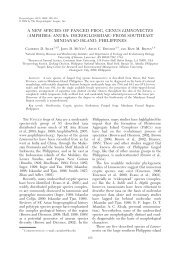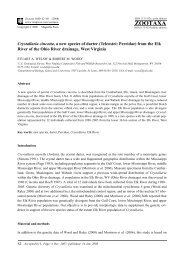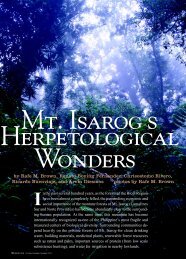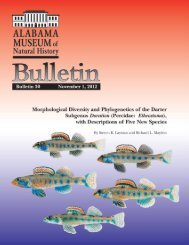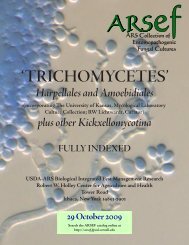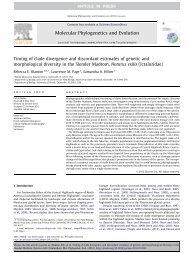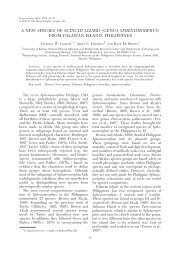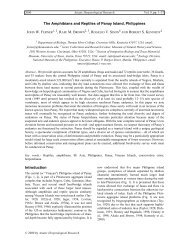New Flap-Legged Forest Gecko (Genus Luperosaurus ... - BioOne
New Flap-Legged Forest Gecko (Genus Luperosaurus ... - BioOne
New Flap-Legged Forest Gecko (Genus Luperosaurus ... - BioOne
You also want an ePaper? Increase the reach of your titles
YUMPU automatically turns print PDFs into web optimized ePapers that Google loves.
NEW PHILIPPINE LUPEROSAURUS 203FIG. 1. Map of Luzon Island in relation to the Philippines (inset)with the type locality of <strong>Luperosaurus</strong> angliit (Municipality of Baler,Aurora Province) indicated with an open circle. Comparison of the<strong>Luperosaurus</strong> cumingii syntypes (BMNH 1946.8.22.41 and 1946.8.22.42)to recent collections (UF 77829, TNHC 61910) suggests that Cuming’s(1836–1840) types most probably originated on the Bicol Peninsula(Gaulke et al., 2007).length, tibia–fibula length, first and fourth toe lengths, tailwidth, tail depth, number of supralabials and infralabialsposteriorly to the point labials are no longer differentiated;preanofemoral pore-bearing scales, subdigital lamellae underfingers and toes, transverse midbody scales, paravertebral andmidventral scales between midpoints of limb insertions, tailannuli, and subcaudals. We employ lineage-based speciesconcepts (Simpson, 1961; Wiley, 1978; Frost and Hillis, 1990; deQueiroz, 1999) in an effort to recognize ancestor-descendentpopulation segments with a distinct evolutionary history,evidence of lineage cohesion, and in cases where thehypothesis of conspecificity can be confidently rejected (Brownand Diesmos, 2002; Brown and Guttman, 2002; Gaulke et al.,2007).SYSTEMATICS<strong>Luperosaurus</strong> angliit sp. nov.Figures 2–4Holotype.—PNM 9702 (Field Collection number ACD 3678),adult female, collected at 1930 h by Arvin C. Diesmos 5 April2008, 91 m above sea level, Barangay Zabali, Municipality ofBaler, Aurora Province, Luzon Island, Philippines (15.742uN;121.576uE; Fig. 1). The holotype was captured on the perimeterfence surrounding the main administration building on thecampus of Aurora State College of Technology.Paratypes.—KU 321815 (ACD 4901), PNM 9703 (ACD 4902),adult males, collected 5 July 2009, by Arvin C. Diesmos on treetrunks in coastal forest at sea level, Sitio Casapsapan, BarangayCulat, Municipality of Casiguran, Aurora Province, LuzonIsland (16.293uN; 122.186uE); KU 308023 (RMB 7343), collected12 February 2007 by J. Fernandez and C. Oliveros on a primaryforest tree trunk, 350 m above sea level, Barangay Balatubat-Kauringan, Municipality of Calayan, Cagayan Province,Camiguin Norte Island.Referred Specimens.—We tentatively refer the followingspecimens to L. angliit with the caveat that the absence ofreliable locality data, or the immature or poorly preserved stateof the material, render identification somewhat questionable:KU 326160: approximately 800 m on Mt. Makiling, Universityof the Philippines at Los Baños upper campus, forestry nurseryarea, Barangay Batong Malake, Municipality of Los Baños,Laguna Province, Luzon Island; PNM 7242: Municipality ofLooc, Oriental Mindoro Province, Lubang Island; CAS 62453–62454: vicinity of Polillo Town; Polillo Island, Municiplity ofPolillo, Quezon Province, Polillo Island; NMW 17985:1:‘‘Camiguin’’ (presumably Camiguin Norte Island, CagayanProvince, northeast of Luzon island); SMF 9044: ‘‘CentralLuzon, Philippines’’; ZMB 5578: ‘‘Philippines.’’Diagnosis.—The new species is distinguished from all speciesof <strong>Luperosaurus</strong> by (1) its relatively small, slender body; (2)reduced interdigital webbing; (3) reduced cutaneous expansionsbordering the limbs; (4) absence of ventrolateral bodytubercles; (5) absence of spinose tubercles on edges ofcutaneous expansions ordering the limbs; (6) the presence ofonly a few ventrolateral tubercles on the caudal margin of eachtail whorl; (7) postrictal and nuchal tubercles absent; (8)precloacofemorals 17–19; (9) relatively low numbers of supralabialsand infralabials; and (10) low subdigital scansorscounts. A summary of the distribution of diagnostic characterstates in Philippine <strong>Luperosaurus</strong> is presented in Table 1.Comparisons.—The critical comparison for the recognition ofthe new species is to L. cumingii, the taxon with which L. angliithas so long been confused. <strong>Luperosaurus</strong> angliit differs from L.cumingii by SVL 59.4–64.7 (vs. 73.4–82.7), enlarged scales in theprecloacofemoral series 17–19 (vs. 20–28), midbody scales 162–182 (vs. 184–199), supralabials 12–15 (vs. 15–17), Toe I scansors9–10 (vs. 12–14), Toe IV scansors 11–13 (vs. 15–16), the absence(vs. presence) of spinose postrictal, nuchal, and ventrolateralbody tubercles, reduction (1/3–1/2) of interdigital webbingbetween fingers and toes (vs. 1/2–2/3), limitation of ventrolateraltail tubercles to one or two small tubercles on the caudalmargin of each tail segment (vs. entire ventrolateral tail marginlined with highly spinose, recurved tubercles), and reductionof cutaneous expansions bordering the limbs (vs. cutaneousexpansions extensive throughout limbs; Table 1).Snout–vent length of the new species (59.4–64.7) distinguishesit from L. corfieldi (70.0–95.0), L. kubli (105.4), L. palawanensis(43.7, 52.0), L. joloensis (27.5, 32.4), and L. gulat (81.3). Thenumber of differentiated (enlarged) scales in the precloacofemoralseries of L. angliit (17–19) distinguishes it from L. kubli(16), L. palawanensis (28–32), L. joloensis (30–31), and L. gulat(40). Supralabials (12–15) distinguish the new species from L.gulat (11); infralabials (14–15) distinguish L. angliit from L.corfieldi (12–14), L. kubli (12), L. palawanensis (10–11), L. joloensis(10–12), and L. gulat (11). The number of Toe I scansors (9–10)and Toe IV scansors (11–13) distinguishes L. angliit from L.corfieldi (Toe I: 10–14; Toe IV:14–20) and L. kubli (Toe I: 12; ToeIV: 16); the number of Toe III scansors (11–13) distinguishes thenew species from L. corfieldi (14–20) and L. kubli (16). Theabsence of postrictal and nuchal tubercles distinguishes L.angliit from L. palawanensis and L. joloensis, and the absence ofventrolateral body tubercles distinguishes L. angliit from L.



